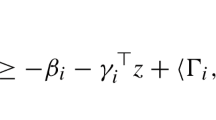Abstract
We study an upper bound on the max-cut problem defined via a relaxation of the discrete problem to a continuous nonlinear convex problem, which can be solved efficiently. We demonstrate how far the approach can be pushed using advanced techniques from numerical linear algebra and nonsmooth optimization. Various classes of graphs with up to 50 000 nodes and up to four million edges are considered. Since the theoretical bound can be computed only with a certain precision in practice, we use duality between node- and edge-oriented relaxations to estimate the difference between the theoretical and the computed bounds.
Zusammenfassung
Es wird eine obere Schranke für das Max-Cut Problem untersucht, die sich aus einer Relaxation des diskreten Problems zu einem stetigen, nichtlinearen konvexen Problem ergibt. Die Relaxation ist polynomial lösbar. Es werden die Grenzen des Ansatzes unter dem Einsatz fortgeschrittener Methoden aus numerischer linearer Algebra und nichtglatter Optimierung untersucht. Verschiedene Graphenklassen mit bis zu 50 000 Knoten und 4 Millionen Kanten werden mit dem Ansatz behandelt. Da die theoretische obere Schranke in der Praxis nur mit einer gewissen Genauigkeit bestimmt werden kann, wird ein Dualitätsmodell zwischen knoten- und kantenorientierten Relaxationen verwendet, um den Unterschied zwischen der theoretischen und der berechneten Schranke abzuschätzen.
Similar content being viewed by others
References
Barahona, F.: The max-cut problem in graphs not contractible toK 5. Oper. Res. Lett.2, 107–111 (1983)
Barahona, F., Grötschel, M., Jünger, M., Reinelt, G.: An application of combinatorial optimization to statistical physics and circuit layout design. Oper. Res.36, 493–513 (1988).
Barahona, F., Jünger, M., Reinelt, G.: Experiments in quadratic 0–1 programming. Math. Programm.44, 127–137 (1989).
Barahona, F., Titan, H.: Max mean cuts and max cuts. In: Combinatorial optimization in science and technology (extended abstracts), DIMACS Report 91-18, Rutgers University, New Brunswick, New Jersey, pp. 30–45 1991.
Delorme, C., Poljak, S.: Laplacian eigenvalues and the maximum cut problem. Math. Programm.62, 557–574 (1993).
deSimone, C., Rinaldi, G.: A cutting plane algorithm for the max-cut problem. Technical Report Report 346, IASI Rome, 1992.
Deza, M., Laurent, M.: Applications of cut polyhedra. Technical Report LIENS-92-18, Ecole Normale Supérieure, Paris, 1992.
Hadlock, F. O.: Finding a maximum cut of a planar graph in polynomial time. SIAM J. Comput.4, 221–225 (1975).
Karp, R. M.: Reducibility among combinatorial problems. In: Complexity of computer computation (Miller, R. E., Thather, J. W., eds.), pp. 85–103. New York: Plenum Press 1972.
Laurent, M., Poljak, S.: The metric polytope. Proc. of IPCO 1992 (Balas, E., Cornuejols, G., Kannan, R., eds.), pp. 274–286, 1992.
Lengauer, T.: Combinatorial algorithms for integrated circuit layout. Chichester: J. Wiley 1990.
Mohar, B., Poljak, S.: Eigenvalues and the max-cut problem. Czech. Math. J.40, 343–352 (1990).
Orlova G. I., Dorfman, Y. G.: Finding the maximal cut in a graph. Eng. Cybernetics10, 502–504 (1972).
Pardalos, P. M., Rodgers, G. P.: Computational aspects of a branch and bound algorithm for quadratic zero-one programming. Computing45, 131–144 (1990).
Poljak, S.: Polyhedral and eigenvalue approximations of the max-cut problem. In: Sets, graphs and numbers, (Miklós, D., Halász, G., Lovász, L., Szönyi, T., eds.), pp. 568–581. Amsterdam: North-Holland 1992.
Poljak, S., Tuza, Zs.: On the expected relative error of the polyhedral approximation of the max-cut. Technical Report Report 92757-OR, Institut für Diskrete Mathematik, Universität Bonn, 1992.
Rendl, F., Poljak, S.: Nonpolyhedral relaxations of graph bisection problems. Technical Report, University of Technology Graz, 1992.
Rendl, F., Poljak, S.: Solving the max-cut problem using eigenvalues. Technical Report, University of Technology Graz, 1991.
Rendl, F., Vanderbei, R. J., Wolkowicz, H.: Interior-point methods for max-min eigenvalue problems. Technical Report SOR-93-15, Princeton University, 1993.
Schramm, H., Zowe, J.: A combination of the bundle approach and the trust region concept. In: Advances in mathematical optimization (Guddat, J., et al. eds.), pp. 196–209. Berlin: Akademie Verlag 1988.
Schramm, H., Zowe, J.: A version of the bundle idea for minimizing a nonsmooth function: conceptual idea, convergence analysis, numerical results. SIAM J. Optimization2, 121–152 (1992).
Scott, D. S.: Block Lanczos software for symmetric eigenvalue problems. Technical Report ORNL/CSD-48, Oak Ridge National Laboratory, 1979.
Simon, H.: Personal communication. NASA Ames Research Center, Moffett Field, CA, 1993.
Author information
Authors and Affiliations
Additional information
Parts of this research were carried out while visiting the Institute of Mathematics, Academia Sinica, Nankang, Taipei, Taiwan 11529, supported by a research grant of the National Science Council of R.O.C.
Partial financial support from “Christian Doppler Labor-Diskrete Optimierung” is gratefully acknowledged.
Rights and permissions
About this article
Cite this article
Poljak, S., Rendl, F. Node and edge relaxations of the Max-cut problem. Computing 52, 123–137 (1994). https://doi.org/10.1007/BF02238072
Received:
Issue Date:
DOI: https://doi.org/10.1007/BF02238072




